Since the last time the Center studied online dating in 2019, the market has evolved, users have continued looking for love, and the platforms have carried some through dating amid the COVID-19 pandemic. But while online dating has upsides, some downsides – ranging from burnout to harassment – have also prompted collective reflection on daters’ well-being and how companies running the platforms should respond.
Asked to describe their own experiences with online dating, Americans report positives and negatives. While about half of those who have ever used a dating site or app say their overall experiences have been positive, others report encountering harassment or being scammed. Even as many Americans who have used dating sites and apps in the past year are excited about the people they have seen on them, notable shares also report feeling overwhelmed by messages they have received. And some users are not convinced that the companies that run the platforms are doing a good job addressing related issues.
Americans who have used dating sites, apps are somewhat divided on whether their experiences have been positive or negative
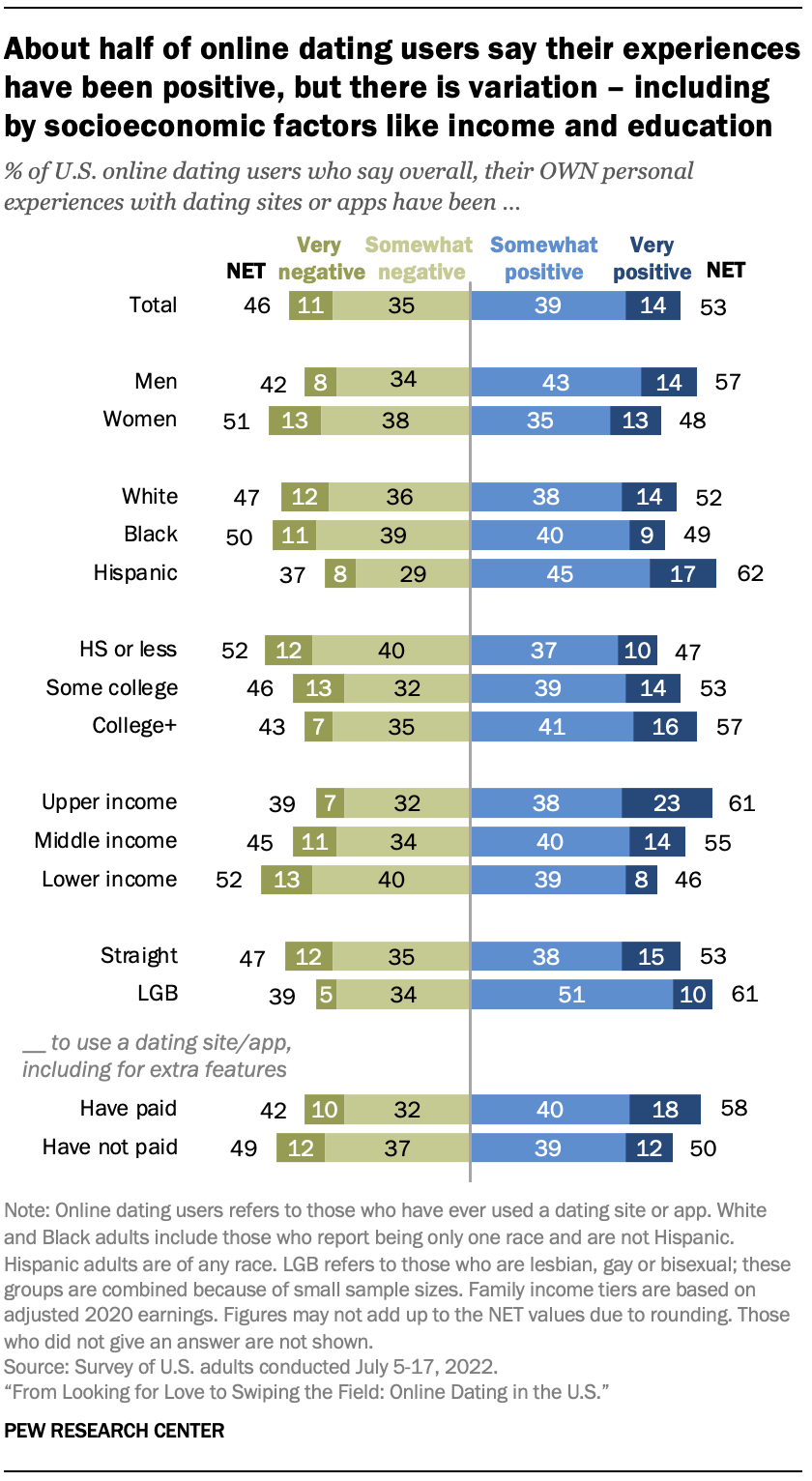
Users’ descriptions of their online dating experiences are far from one-size-fits-all. About half of Americans who have used a dating site or app (53%) say their personal experiences have been very or somewhat positive, while only a slightly smaller share (46%) say they have been very or somewhat negative.
Roughly half or more users across most major demographic groups describe their experiences in positive terms, but there is some variation. For example, those with mid-range or higher household incomes are more likely than those with lower incomes to say their experiences have been positive.
Experiences also vary by formal education: Having a bachelor’s degree is associated with more positive overall experiences dating online, compared with having a high school diploma or less schooling. (The share of those with some college experience who say their time on dating sites and apps has been positive is statistically similar to those with less or more formal education.)
Women are more likely than men to describe their experiences as negative overall, as are straight users compared with those who are lesbian, gay or bisexual. White or Black adults who have ever used one of these platforms are more likely to say their experiences have been negative than are Hispanic users.
Overall, the shares of users who say their experiences have been positive or negative are statistically unchanged from 2019. However, women who have ever used a dating site or app are now slightly more likely to describe their experiences as negative, up 7 percentage points from the share who said so in 2019. Online dating users with a bachelor’s or advanced degree are also somewhat more likely to say this now than in the previous survey – a 6-point increase in the share characterizing their experiences as negative.
Aside from demographics, users who have paid for platforms or “premium” features – which is especially common among those with higher incomes – are also more likely to say their time on dating sites or apps has been positive in the current survey, compared with users who have not paid for these services (58% vs. 50%). But this is only true for some demographic groups.
For example, men who have paid for dating platforms or their features are more likely to say their experiences have been positive compared with men who have used dating platforms but have not paid to use them (63% vs. 53%). There are also differences by paying or not in how people describe their experiences among users 50 and older – 58% of users in this age group who have paid say their experiences have been positive, versus 45% of those who have not paid – and among straight online dating users who have paid compared with those who have not (58% vs. 49%).
But among women users, online dating users younger than 50, and LGB users, there are no differences in the shares who say their experiences have been positive by whether they have paid for dating sites or apps.
Women who have used dating sites, apps in past year about three times as likely as men to say they often felt overwhelmed by number of messages
Recent commentary on online dating has raised questions about its emotional impact – particularly among users despondent for lack of “success” or “burned out” from their experiences. Asked for their reactions to what they have encountered in the past year, Americans who have used dating sites or apps in that time frame report a mix of emotions.
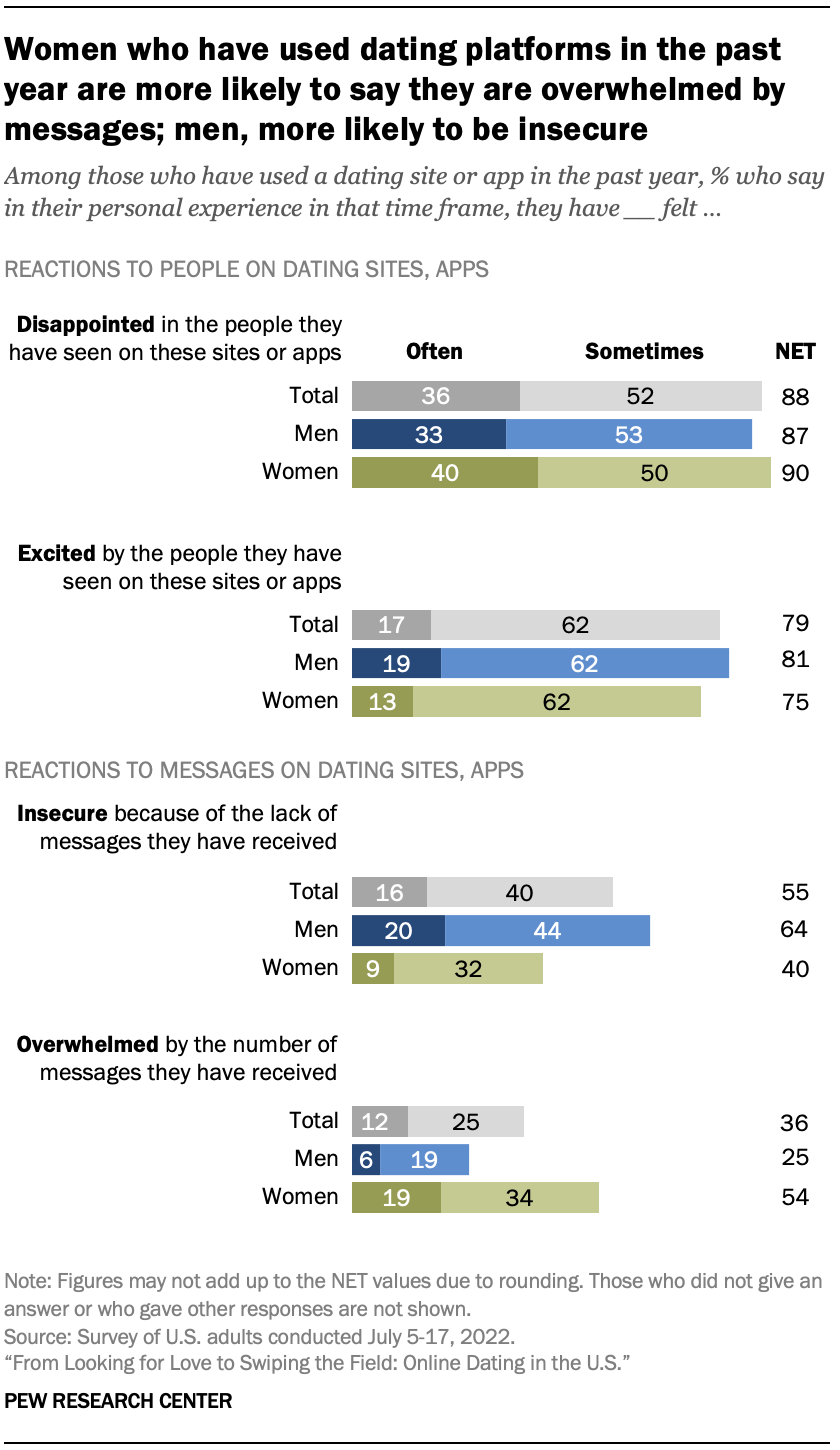
Roughly nine-in-ten Americans who have used dating sites or apps in the past year report feeling at least sometimes disappointed by the people they have seen on these platforms, while about eight-in-ten report feeling at least sometimes excited. But about twice as many current or recent online dating users say they often feel disappointed than say they often feel excited.
Some 55% of current or recent online dating users say they have at least sometimes been insecure about the number of messages they received over the past year, while fewer (36%) say they have felt overwhelmed by that number.
But reactions to how many people reach out on online dating platforms differ sharply by gender. Among current or recent online dating users, women are far more likely than men to say they have felt overwhelmed by the number of messages they received in the past year; the reverse is true for feeling insecure, with men far more likely to say so than women. About one-in-five women who have used dating sites or apps in the past year report often feeling overwhelmed by the volume of messages they get; a similar share of men say they have often felt insecure about this.
LGB current or recent online dating users are more likely than their straight counterparts to say they have been overwhelmed by message volume at least sometimes over the past year (47% vs. 30%). And current or recent users who have ever paid for a site, app or its features are more likely than those who have never paid to say a lack of messages has made them insecure over the past year (64% vs. 48%).
Roughly half of those who have used dating sites or apps think they have come across a scammer
Browsing profiles and getting to know people online presents opportunities for romance, but also opens the door to those who have less-noble intentions.
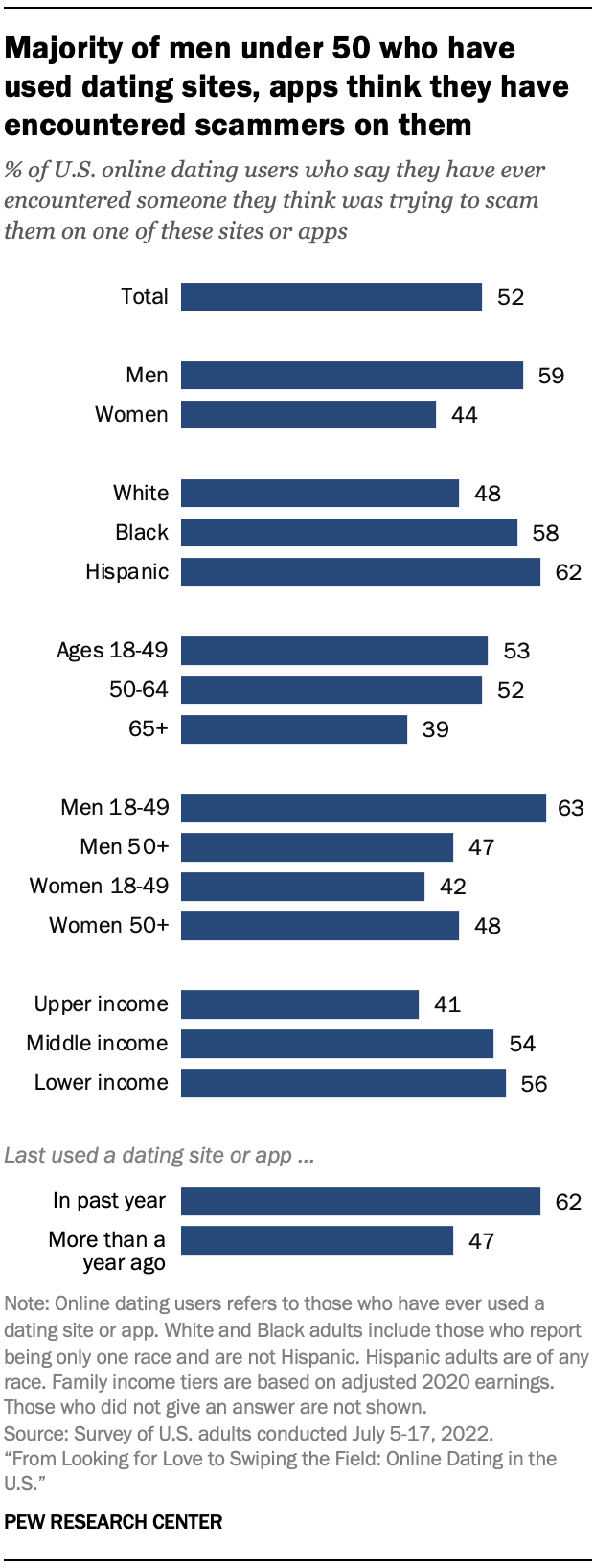
About half of Americans who have ever used a dating site or app (52%) say they have come across someone who they think was trying to scam them on the platforms.
Men who have used dating sites or apps are more likely than women to say so, and this is especially true for men under 50: 63% of this group say they think they have encountered a scammer on them, compared with smaller shares of men 50 and older and women of any age.
Aside from gender and age, household income is a factor. While similar shares of online dating users with lower (56%) and mid-range (54%) household incomes think they have come across a scammer on dating sites or apps, a smaller share of those with relatively high household incomes (41%) say the same.
And experiences with scammers also vary by race and ethnicity: About six-in-ten Hispanic or Black online dating users think they have encountered one on the platforms, compared with about half of their White counterparts.
Those who have used dating sites or apps in the past year are also more likely than those who have used them longer ago to say they have encountered a potential scam (62% vs. 47%). Fully 72% of men who are current or recent online dating users think they have come across a scammer at some point.
Experiences with harassment on dating sites, apps especially common among women under 50, LGB users
Journalists, companies that run dating sites and apps, and lawmakers have all weighed in on the topic of harassment on dating sites in recent years. For some users, troubling experiences are part of the reality of online dating.
About four-in-ten adults who have ever used a dating site or app (38%) report receiving unwanted sexually explicit messages or images at some point on the platforms, while three-in-ten say they have had someone contact them after they said they were not interested. About a quarter (24%) report being called an offensive name. And 6% say they have been threatened with physical harm.
All told, about half of those who have ever used a dating site or app (48%) have experienced at least one of these four unwanted behaviors the Center survey explored.
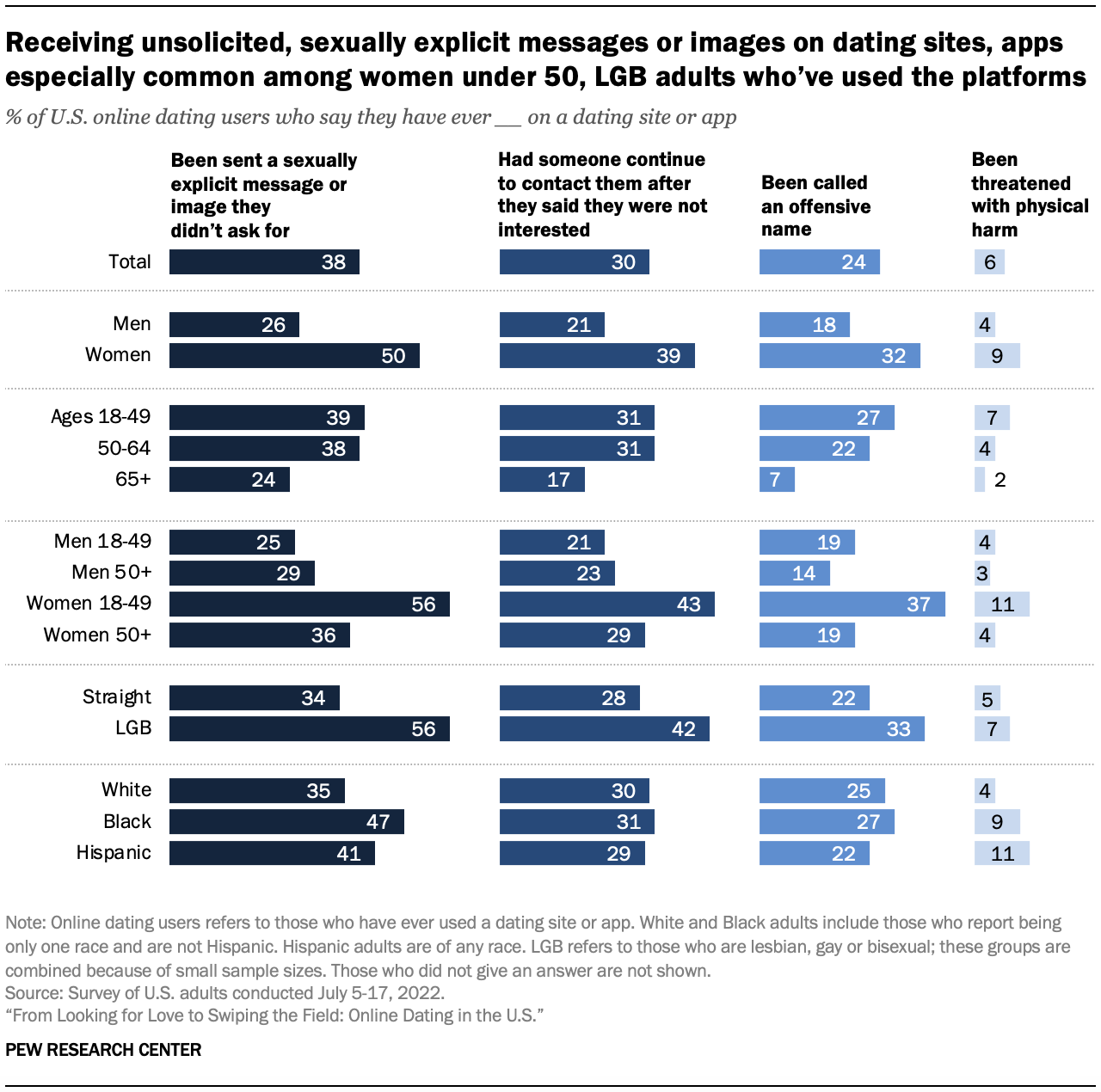
Women who have ever used a dating site or app are more likely to report experiencing each of these four things on a dating platform compared with men – and this is especially true for women under 50. For example, 56% of women under 50 who have used dating sites or apps have been sent unwanted sexually explicit messages or images on one. This is 20 points greater than the share of women 50 and older and 30 points greater than the share of men (of any age) who say the same. Some 43% of women under 50 who have used dating sites or apps have experienced continued unwanted contact; 37%, offensive name-calling; and 11%, physical threats.
There are also double-digit differences by sexual orientation among those who have used dating sites or apps: LGB users are more likely than straight users to say they have ever received unwanted sexual messages or images (56% vs. 34%), experienced unwanted continued contact (42% vs. 28%), or been called offensive names (33% vs. 22%).
And Black users are more likely than White users to say they have received unwanted sexual images or messages, while Hispanic users are more likely to report receiving physical threats than their White counterparts.
Online dating users more negative than positive about companies’ efforts to root out fake accounts; reverse is true for keeping users’ data safe
The more troublesome experiences that some online dating users face have led to calls for companies to do more to protect their users. Americans who have ever used these platforms report mixed feelings about the job companies do in three respects: finding and removing fake accounts, removing users who abuse or harass others and keeping users’ personal information safe.
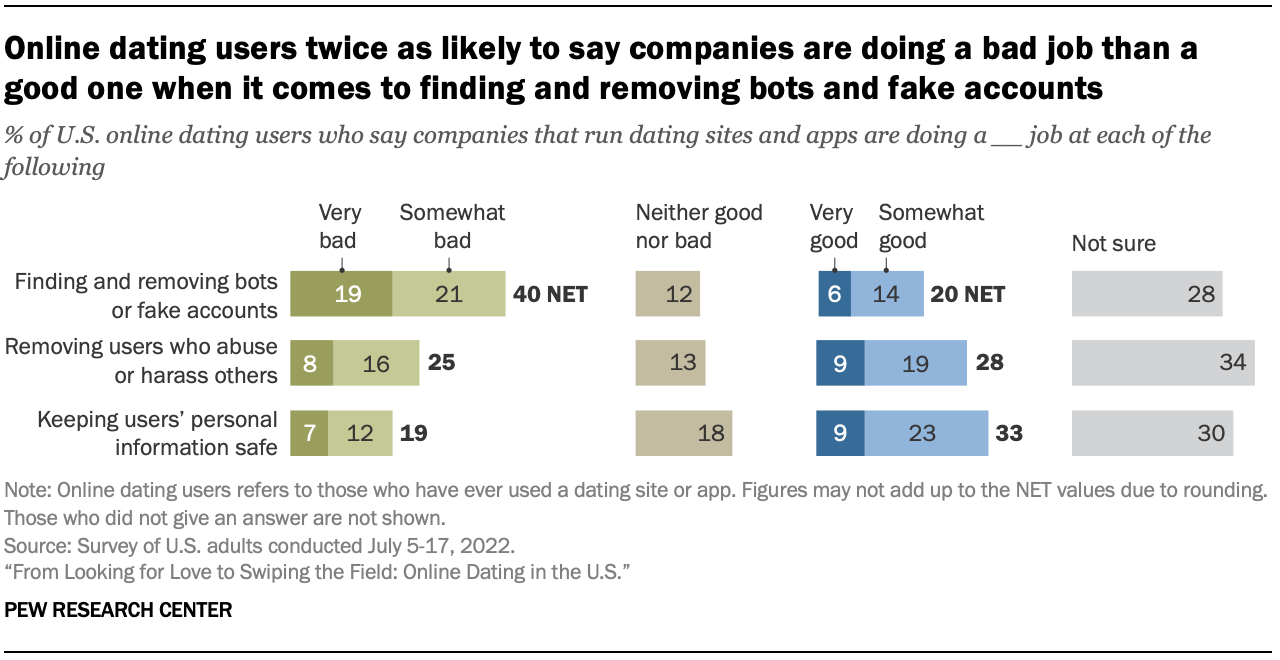
About one-in-ten or fewer online dating users say companies are doing a very good job at these things. Yet in each case, notable shares of users say they are not sure or think the companies are doing neither a good nor bad job.
When it comes to rooting out bots or fake accounts, online dating users’ views of companies lean negative: Four-in-ten say companies have done a very (19%) or somewhat (21%) bad job. By comparison, one-in-five say the companies have done a very (6%) or somewhat (14%) good job and 12% say it’s been neither good nor bad.
But users are more positive than negative about the companies’ efforts to keep their personal information safe: 33% say companies are doing a good job, compared with 19% who say a bad job. Another 18% say neither good nor bad.
And they are about evenly split in their assessments of companies’ efforts to remove those who abuse or harass people on the platforms, with about a quarter each saying good or bad; about one-in-ten say neither good nor bad.
Across all three of these questions, however, substantial shares of online dating users are not sure what kind of job companies are doing. Some 34% say this about removing users who harass others, 30% about keeping personal information safe and 28% about finding and removing bots or fake accounts.
Aside from demographics, users’ experiences on dating sites and apps shape the marks they give companies at rooting out problems. Those who have experienced at least one of the four unwanted behaviors explored in the survey are more likely than online dating users who have not experienced them to say companies are doing a bad job at removing bots, getting harassers off the platforms or keeping data secure.
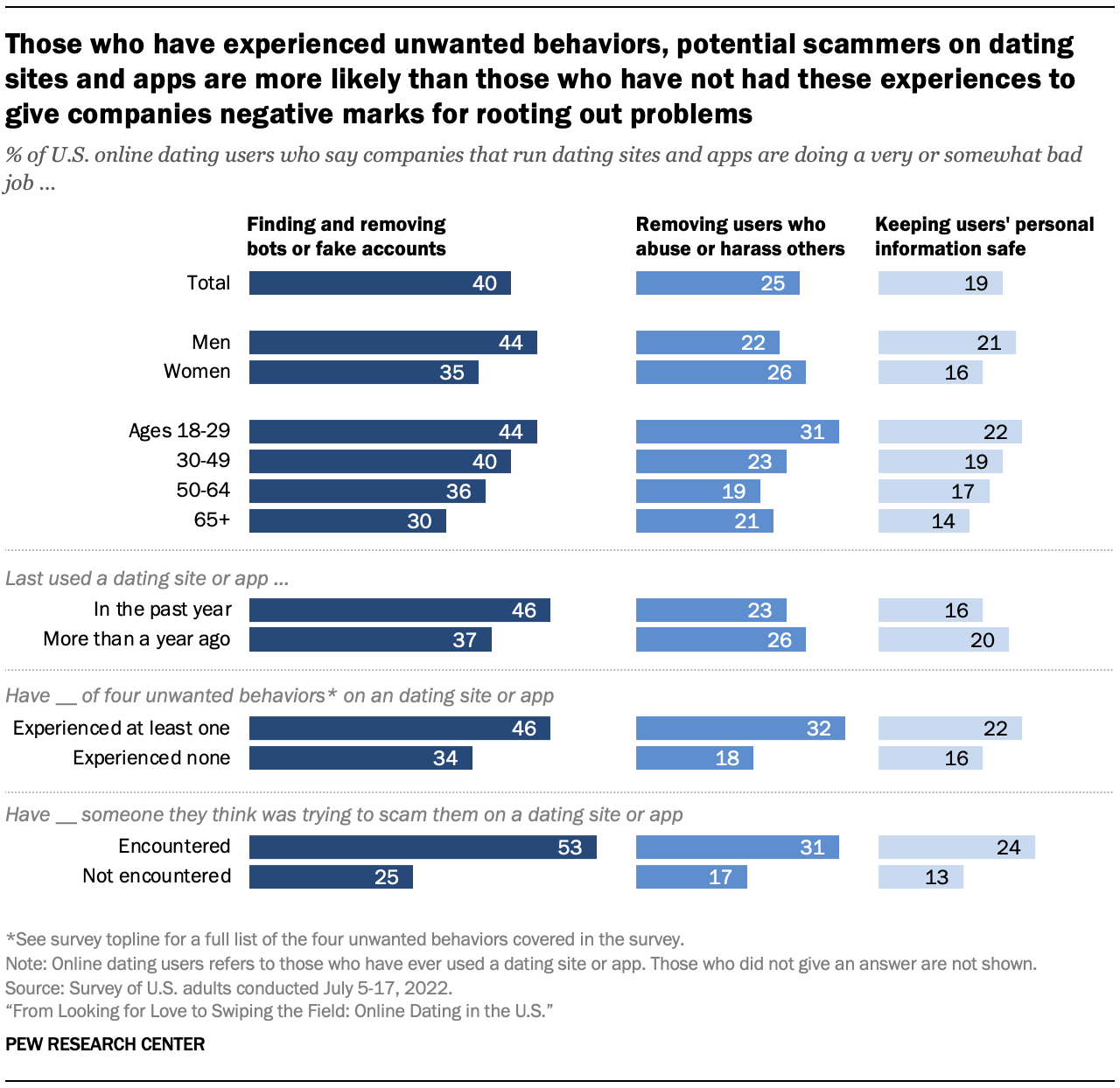
Similarly, those who think they have encountered a scammer on a dating platform also hold more negative views of companies compared with other users: They are about twice as likely as those who have not encountered scams to say companies are doing a bad job at each of the three things the survey explored.
There are also overall differences by gender and age. For example, men who have used dating sites or apps are more likely to say the companies are doing a bad job getting rid of bots and protecting personal information than are women. They are more positive than women, though, about companies’ jobs removing harassers (32% vs. 23% say they are doing a very or somewhat good job).
Users ages 18 to 29 are more likely than other age groups to say companies have done a bad job getting rid of harassers on their platforms. And when it comes to rooting out bots, more users under 50 give companies negative marks compared with their older counterparts (42% vs. 34%).




